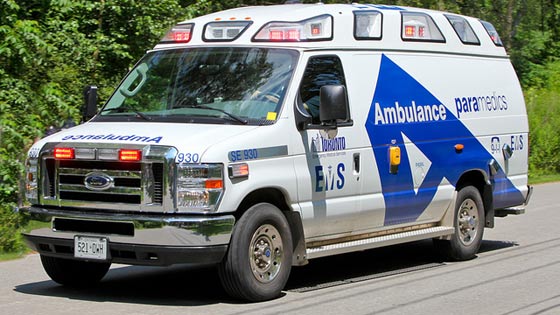
Since 1995, medical experts have learned that "time is brain" -- which means patients having a stroke need to get to the right hospital as quickly as possible for treatment.
(Photo: Google Images)
For Stroke Awareness Month, the stroke program at Krembil Neuroscience Centre is educating the public on this medical emergency that affects 1 Canadian every 10 minutes. On June 12, join Krembil's Stroke Program in the atrium of Toronto Western Hospital between 10 a.m. and 2 p.m. to learn about the warning signs of stroke and how to prevent them.
This is Part 2 of our Stroke Awareness Month series. Stay tuned for Part 3, 'Minor stroke captured on video: Watch as it happens', on Thurs., June 12 -- when we feature a patient who recorded herself having a minor stroke.
Did you know? As recently as the early 1990s, having a stroke wasn't a priority call for medical responders. At the time, there were no existing treatments for stroke and very little that could be done to help patients.
But in 1995, a study demonstrating the benefit of Tissue Plasminogen Activator (tPA) in acute stroke changed all of that. The study showed that tPA , a protein involved in the breakdown of blood clots, was effective in treating ischemic strokes – a stroke where blood is prevented from flowing to the brain and the most common type of stroke.
Although this discovery was an encouraging development, tPA is not appropriate for all stroke patients. tPA cannot be given to patients with hemorrhagic stroke (bleeding in the brain), as it would make the situation much worse. For patients with ischemic stroke, the drug must be given within the first four and a half hours from stroke onset. Therefore, such patients need to get to a hospital quickly to have an immediate CT scan of the brain to confirm that they are not having a hemorrhagic stroke and to start treatment with tPA.
'Time is brain'
tPA was the initial catalyst that prompted medical experts to realize that "time is brain" when it comes to stroke treatment. This means that the more time that passes, the less opportunity there is to intervene in the attack that is occurring on the brain.
1 stroke every 10 minutes
As this new approach to stroke treatment took root in the medical community, practitioners began to look for other ways to reduce the time between the onset of a stroke and a patient receiving treatment.
An estimated 50,000 Canadians suffer a stroke each year, roughly one every ten minutes.
Dr. Frank Silver, neurologist and medical director of the stroke program at UHN's Krembil Neuroscience Centre was at the forefront of lobbying the government to support organized stroke care in Ontario.
"The arrival of tPA really changed the mindset about treating strokes," he recalled. "It was vital to get stroke patients to the right hospital in time and we needed to come up with a system that would facilitate that."
Establishing stroke networks
Back then, not all hospitals had the right resources and expertise to help stroke patients quickly and efficiently, so it was determined that the hospitals that did be designated as stroke centres.
The stroke centre acts as a "hub" for a specific region and patients having a stroke are automatically diverted there by emergency medical responders.
This practice reduces the transfer time between hospitals and ensures quicker treatment.
Central 'hub'
The idea of centralizing a region's stroke care through a designated stroke centre evolved into creating networks within the region. A stroke network creates optimal stroke care for a region since everything is coordinated through the central "hub" of the network. Each network has a director, an educator and a stroke prevention clinic with stroke neurologists and advanced nurse practitioners.
Now known as the Ontario Stroke Network (OSN), this system ensures all patients in Ontario have access to appropriate quality stroke care in a timely manner.
With three stroke centres in Toronto, Toronto Western Hospital is the designated centre for the western part of the city. TWH is highly specialized to treat acute stroke patients and one of few hospitals with a unit dedicated to stroke care.
"Now we know that stroke is time sensitive," said Silver. "We've gone from being able to do nothing for our patients to having many more options available to improve their outcomes, and we hope to keep improving."
Related
